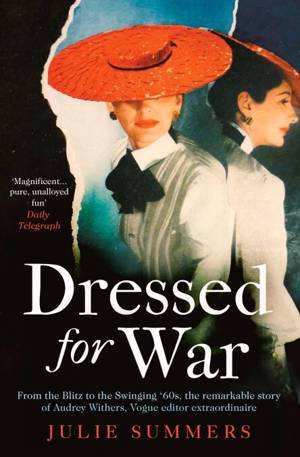
Door een staking bij bpost kan je online bestelling op dit moment iets langer onderweg zijn dan voorzien. Dringend iets nodig? Onze winkels ontvangen jou met open armen!
- Afhalen na 1 uur in een winkel met voorraad
- Gratis thuislevering in België vanaf € 30
- Ruim aanbod met 7 miljoen producten
Door een staking bij bpost kan je online bestelling op dit moment iets langer onderweg zijn dan voorzien. Dringend iets nodig? Onze winkels ontvangen jou met open armen!
- Afhalen na 1 uur in een winkel met voorraad
- Gratis thuislevering in België vanaf € 30
- Ruim aanbod met 7 miljoen producten
Zoeken
Dressed For War E-BOOK
The Story of Audrey Withers, Vogue editor extraordinaire from the Blitz to the Swinging Sixties
Julie Summers
E-book | Engels
€ 10,20
+ 10 punten
Omschrijving
'Magnificent ... Dressed for War works on many levels: as an evocation of an uncommon time; as a celebration of an uncommon woman; as pure, unalloyed fun' Lucy Davies, Daily Telegraph
Dressed For War is the untold story of our most iconic fashion magazine in its most formative years, in the Second World War.
It was an era when wartime exigencies gave its editor, Audrey Withers, the chance to forge an identity for it that went far beyond stylish clothes. In doing so, she set herself against the style and preoccupations of Vogue’s mothership in New York, and her often sticky relationship with its formidable editor, Edna Woolman Chase, became a strong dynamic in the Vogue story.
But Vogue had a good war, with great writers and top-flight photographers including Lee Miller and Cecil Beaton – who loathed each other – sending images and reports from Europe and much further afield – detailing the plight of the countries and people living amid war-torn Europe. Audrey Withers’ deft handling of her star contributors and the importance she placed on reflecting people’s lives at home give this slice of literary history a real edge. With official and personal correspondence researched from the magazine’s archives in London and in New York, Dressed For War tells the marvellous story of the titanic struggle between the personalities that shaped the magazine for the latter half of the twentieth century and beyond.
Dressed For War is the untold story of our most iconic fashion magazine in its most formative years, in the Second World War.
It was an era when wartime exigencies gave its editor, Audrey Withers, the chance to forge an identity for it that went far beyond stylish clothes. In doing so, she set herself against the style and preoccupations of Vogue’s mothership in New York, and her often sticky relationship with its formidable editor, Edna Woolman Chase, became a strong dynamic in the Vogue story.
But Vogue had a good war, with great writers and top-flight photographers including Lee Miller and Cecil Beaton – who loathed each other – sending images and reports from Europe and much further afield – detailing the plight of the countries and people living amid war-torn Europe. Audrey Withers’ deft handling of her star contributors and the importance she placed on reflecting people’s lives at home give this slice of literary history a real edge. With official and personal correspondence researched from the magazine’s archives in London and in New York, Dressed For War tells the marvellous story of the titanic struggle between the personalities that shaped the magazine for the latter half of the twentieth century and beyond.
Specificaties
Betrokkenen
- Auteur(s):
- Uitgeverij:
Inhoud
- Aantal bladzijden:
- 400
- Taal:
- Engels
Eigenschappen
- Productcode (EAN):
- 9781471181597
- Verschijningsdatum:
- 5/02/2020
- Uitvoering:
- E-book
- Beveiligd met:
- Adobe DRM
- Formaat:
- ePub

Alleen bij Standaard Boekhandel
+ 10 punten op je klantenkaart van Standaard Boekhandel
Beoordelingen
We publiceren alleen reviews die voldoen aan de voorwaarden voor reviews. Bekijk onze voorwaarden voor reviews.











